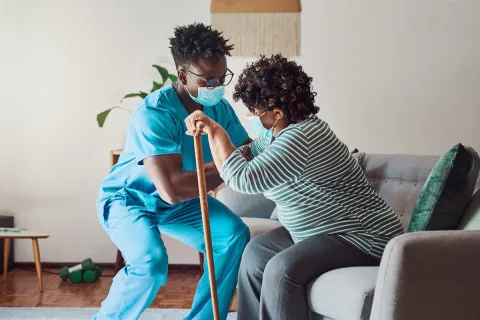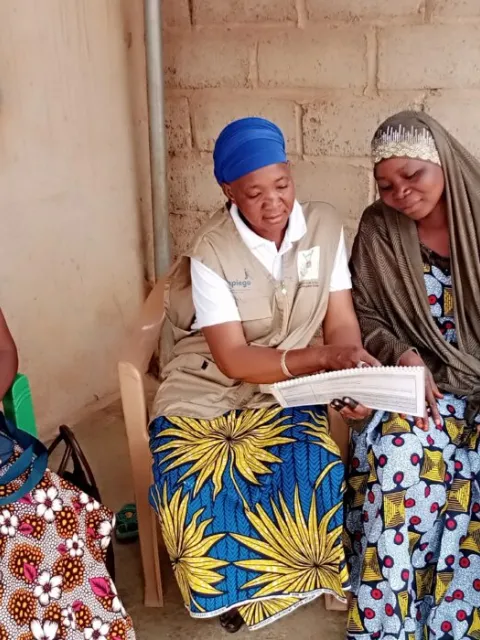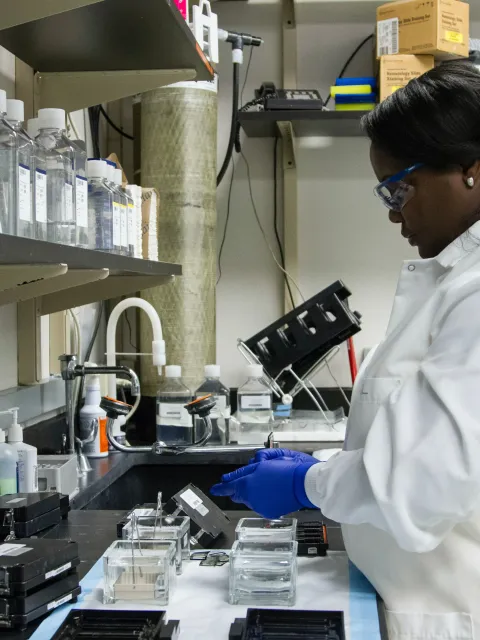Greater access to health services for people with disabilities
There are more than one billion people with disabilities globally, many of whom face systemic discrimination in health care, leading to worse outcomes particularly concerning cancer diagnosis and care.

People with one or more disabilities are part of the largest global minority group. An estimated one billion people or 15% of the world population present at least one long-term physical, mental, intellectual, developmental or sensory impairment. And yet they comprise a population that is largely forgotten when it comes to health concerns.
Many people with disabilities are from lower socioeconomic backgrounds and/ live in low- and middle-income countries. Not only do they generally require medical care specifically for their impairment, they also need general healthcare, including services related to cancer prevention, detection, treatment and care.
This is where people with disabilities face discrimination in the system and barriers to accessing services and receiving care, in addition to financial challenges. These barriers generally relate to attitudes, beliefs and behaviours (attitudinal barriers) on behalf of caregivers; organisational or communication factors, such as information, prescriptions and other services not adapted for people with hearing or vision impairment; and physical barriers that include transportation difficulties, medical equipment that is inaccessible for people due to height or physical impairment, lack of amenities or accessible passages and rooms to accommodate people in wheelchairs or with other disabilities.
For these reasons, people with disabilities are less likely to receive preventative care – for cancer and other non-communicable diseases. They are therefore more likely to suffer from obesity and cardiovascular disease. According to WHO, people with disabilities are three times more likely to be denied health care, four times more likely to be treated badly in the health system and 50% more likely to suffer extreme financial hardship.
Reduce bias and improve the knowledge of healthcare workers
Studies published in the British Medical Journal (BMJ), the American Journal of Physical Medicine & Rehabilitation (AJPM&R) and The Lancet Oncology have found that people with disabilities often face a lack of understanding and knowledge of their rights and needs, and may therefore be subject to stigma, biased attitudes and discrimination.
While caregivers may not be conscious of prejudice, clinical decisions based on assumptions that are influenced by a person’s disability can have serious consequences in terms of care and treatment.
The study conducted in the US (AJPM&R) highlighted the case of a patient with advanced colorectal cancer who had never received a colonoscopy due to breathing difficulties related to polio when other options for screening were available. The study also cited other cases where “initial erroneous attribution of cancer signs or symptoms to patients’ disability or underlying medical conditions delayed cancer diagnosis.”
The study published in the BMJ looked at patients in England Wales, many of whom “raised concerns that their underlying disability may be used to justify less aggressive treatment.” A study published by the American Society of Clinical Oncology (ASCO) also highlighted how treatment decisions can be affected by assumptions about a patient’s functional status or“Performance Status” – their capacity to care for themself and how the cancer impacts their daily living abilities.
Physical and architectural barriers
The fact that health services exist – such as scanners to screen for cancer or radiotherapy machines for treatment – does not mean that everyone is able to use them. For instance: mammography equipment is not adapted for women with mobility disabilities or difficulty with balance; scales and other medical equipment cannot accommodate wheelchairs; diagnostic equipment does not allow patients to transfer from a wheelchair.
The ASCO study highlighted the case of a cancer patient with postpolio syndrome – a nerve and muscle disorder than can cause weakness and pain – who required external beam radiation for prostate cancer. To undergo treatment, he had to either remove his leg braces, requiring about 20 minutes, or keep them – which risked interfering with the radiation treatment. His doctor ultimately chose to conduct the treatment with the braces, in the presence of therapists and physics staff to evaluate.
There are other physical or architectural barriers can be inherent in the building design of a care centre. While they may not always prevent people with disabilities, they do constitute further challenges that may be dissuasive and limit access to care.
The Americans with Disabilities Act lists several barriers that organisations should remove: parking spaces that are too narrow to accommodate people who use wheelchairs; a step or steps at the entrance to the building (no ramps and handrails); round doorknobs or door hardware that is difficult to grasp; and aisles that are too narrow for a person using a wheelchair.
Similar, as well as additional barriers, exist In low-income settings, according to studies conducted in Peru and Ghana. Participants also showed a lower probability of seeking care when the medical facility had no ramps, handrails, adapted bathrooms, elevators or information counters.”
Communication barriers
Clear, accessible and useable information on cancer risks and prevention, how to navigate a medical facility, or access and use a particular service, is essential to guaranteeing that all people can seek out and receive the care they need.
Yet there is a lot of essential information that is not communicated effectively to people with disabilities. For instance, WHO cites the limited availability of written material or sign language interpreters for people with a hearing impairment; health information or prescriptions that are unavailable in Braille or other formats for people with vision impairment; health information presented in complicated ways rather than using plain language and visual and/or auditory aids, avoiding unnecessary medical jargon.
“Life without communication is like being a wall in a room full of people – you are lucky if people talk to you,” the organisation Communication Disabilities Access Canada (CDAC) explains about the importance of effective communication. Indeed, when someone cannot access the information they need, they may feel disconnected, left out and isolated. Furthermore, people with disabilities are often confronted with the belief that because they cannot speak, hear or see well – or are unable to perform a certain function – and that they cannot make their own decisions. A patient reports on the CDAC website: “I had a medical procedure that I didn’t consent to. They didn’t give me a chance to use my letter board to get the information I needed.”
How can we overcome barriers to care for people with disabilities
Providing people with disabilities with effective access to health care is essential to achieving the third Sustainable Development Goal (SDG3), the right to health, as well as Universal Health Coverage.
WHO lists a number of responses for Member States to improve access to and coverage of health services for people with disabilities, and the International Centre for Evidence in Disability published a report in 2019, The Missing Billion, which offers several recommendations for global policy makers, governments, funders and implementers and advocates.
In particular, the report calls on all stakeholders to recognise the needs of people with disabilities as a large vulnerable population and ensure that these needs are met in all health services, programming and trainings. It asks policy makers and governments to include these needs in UHC and SDG 3 action plans and develop or reform health and disability laws, policies and plans. People with disabilities should also, of course, be included along with other vulnerable and marginalised populations in all national cancer control plans.
Last update
Tuesday 30 August 2022
